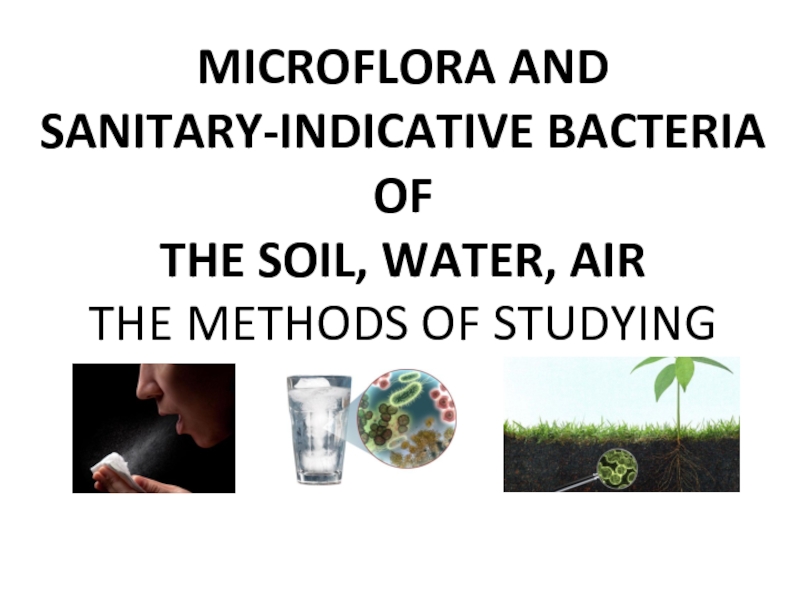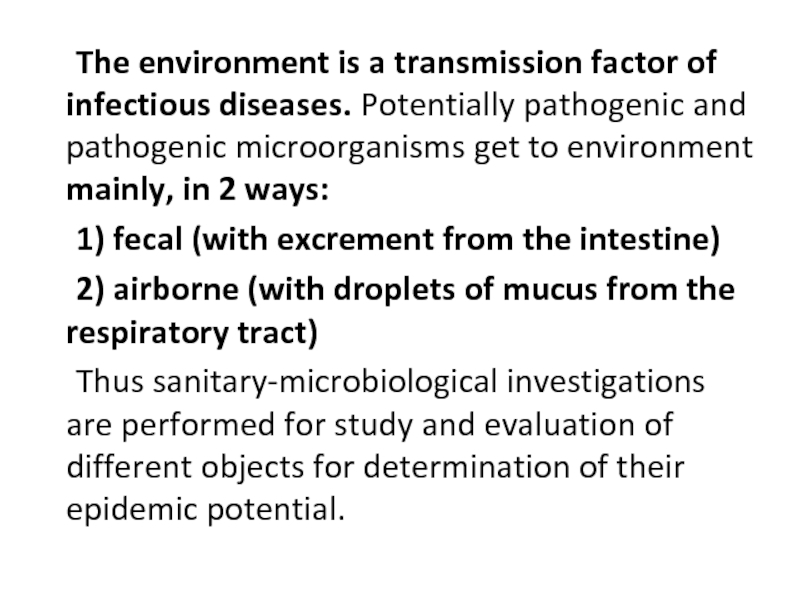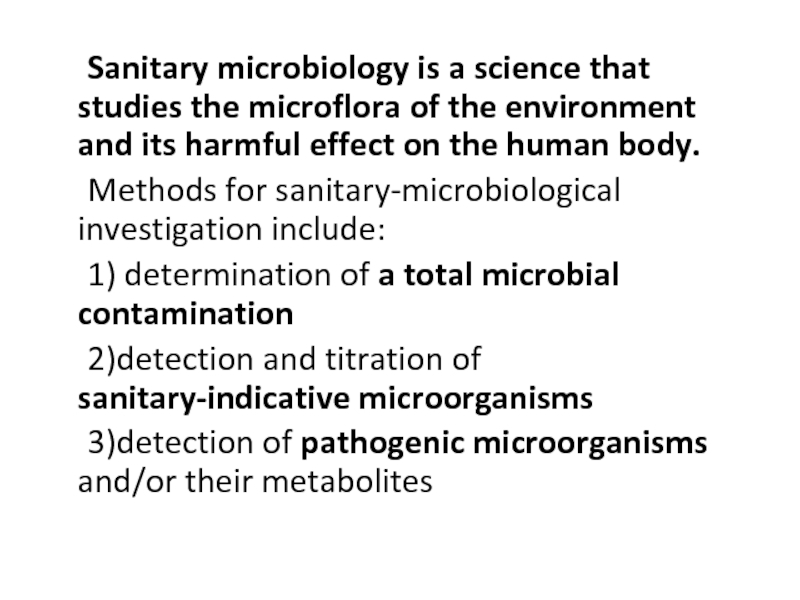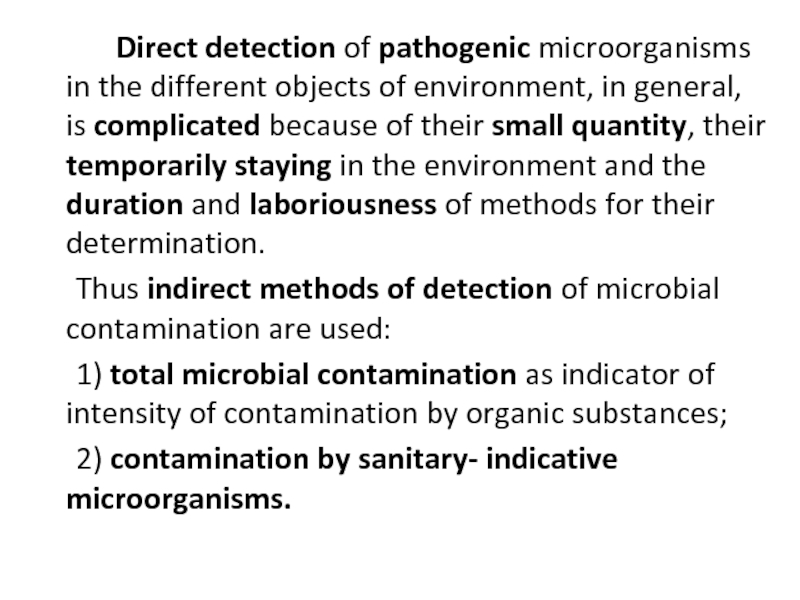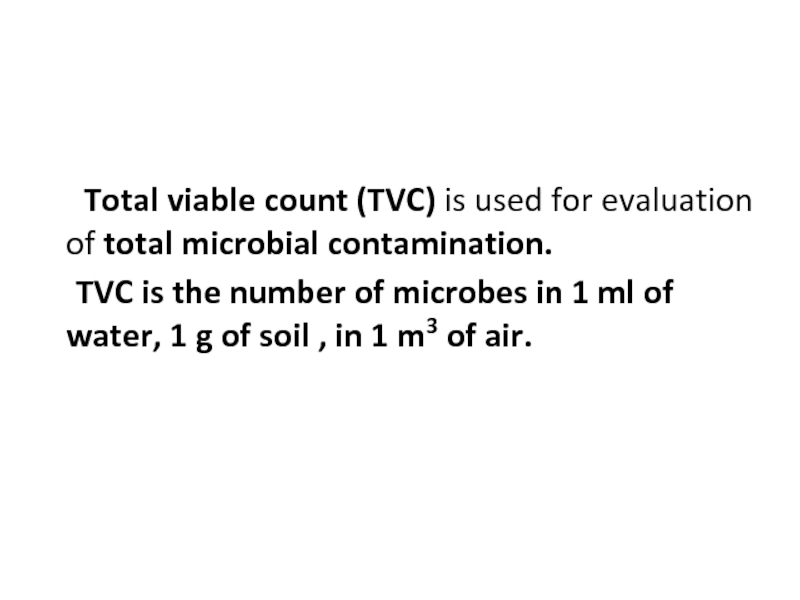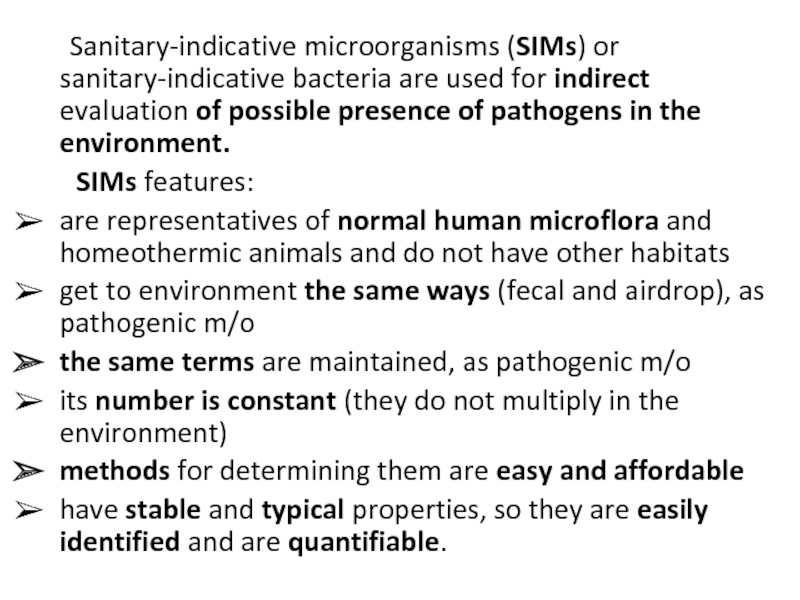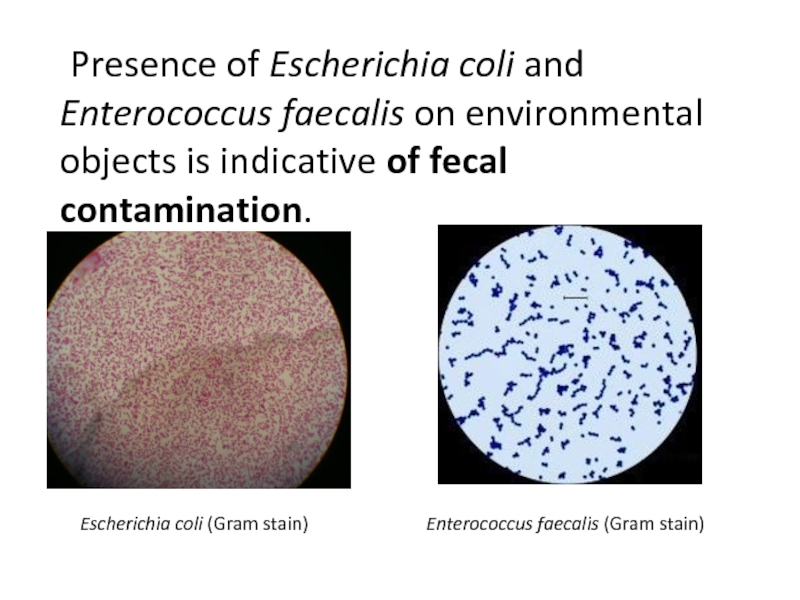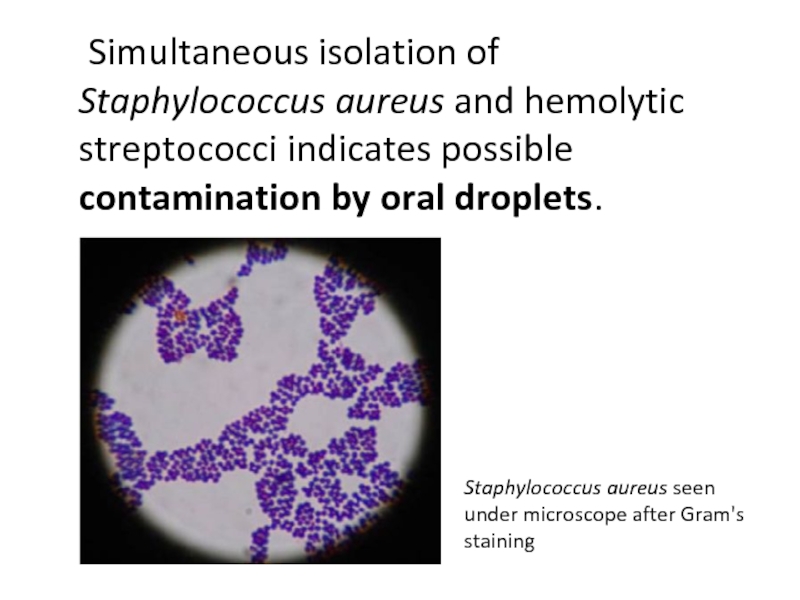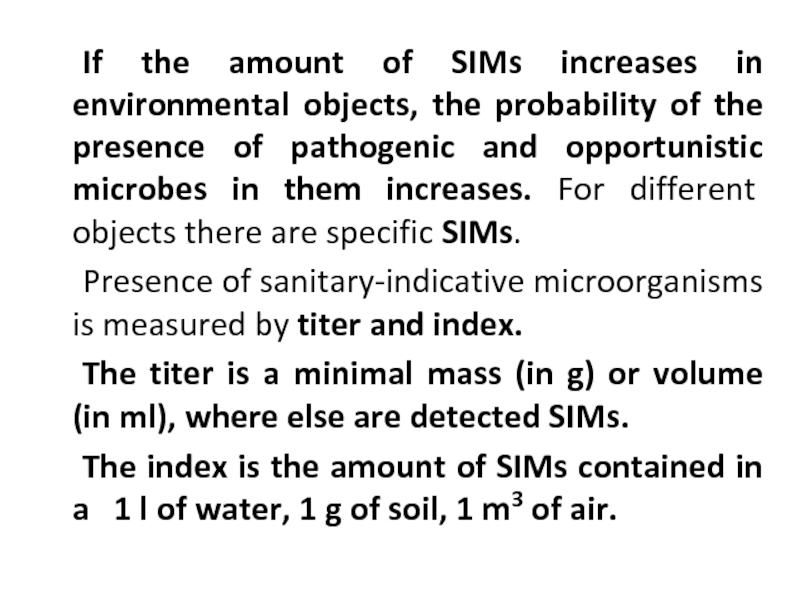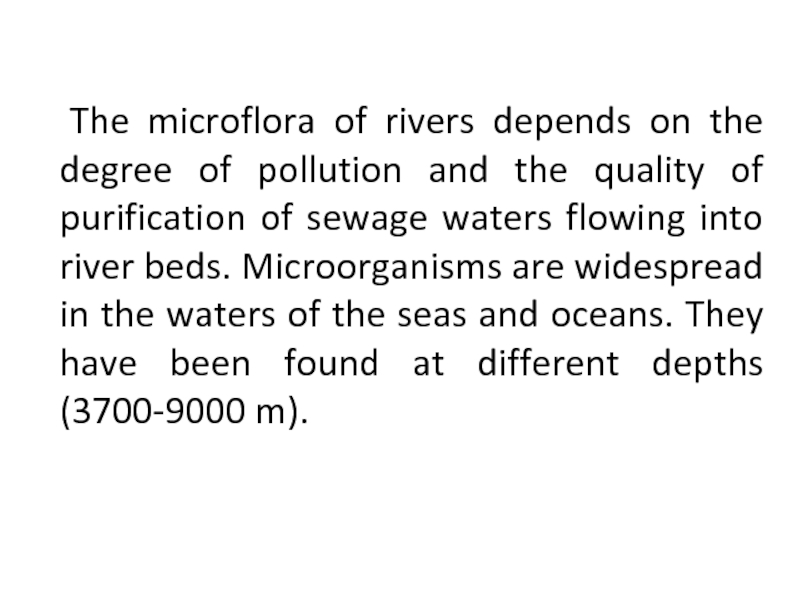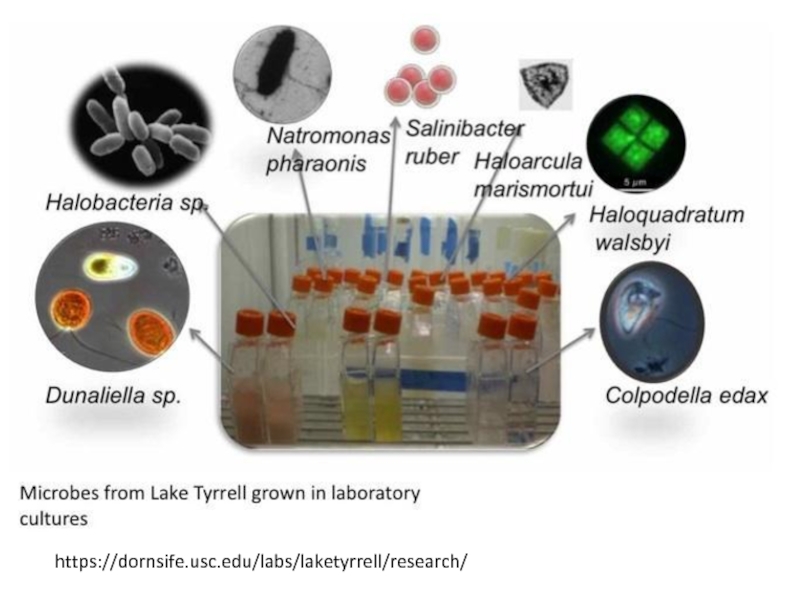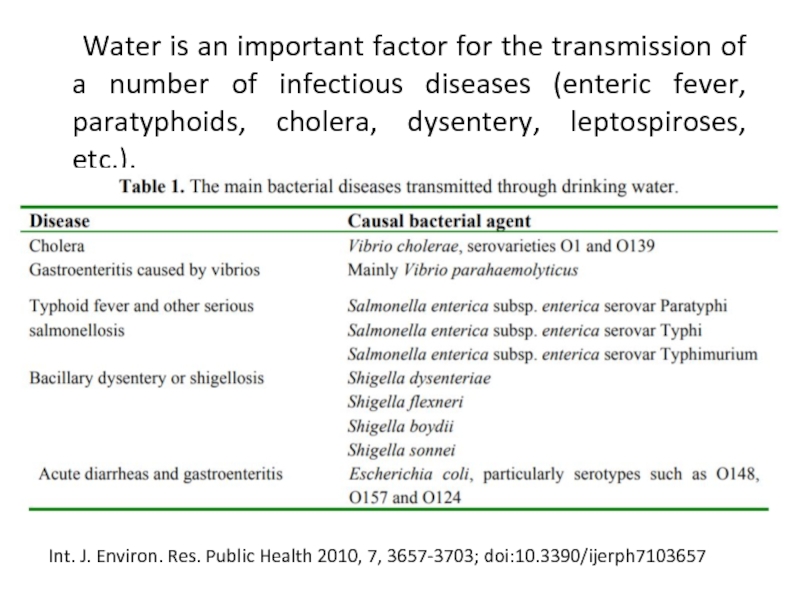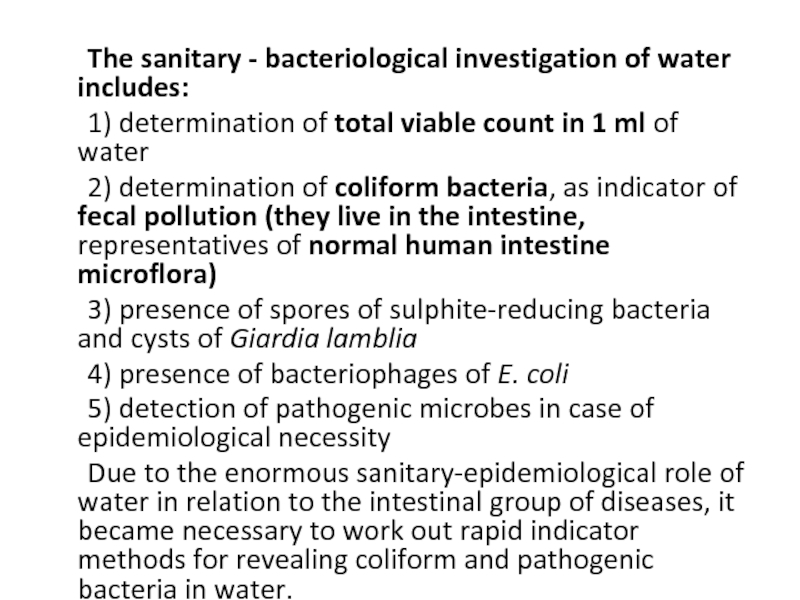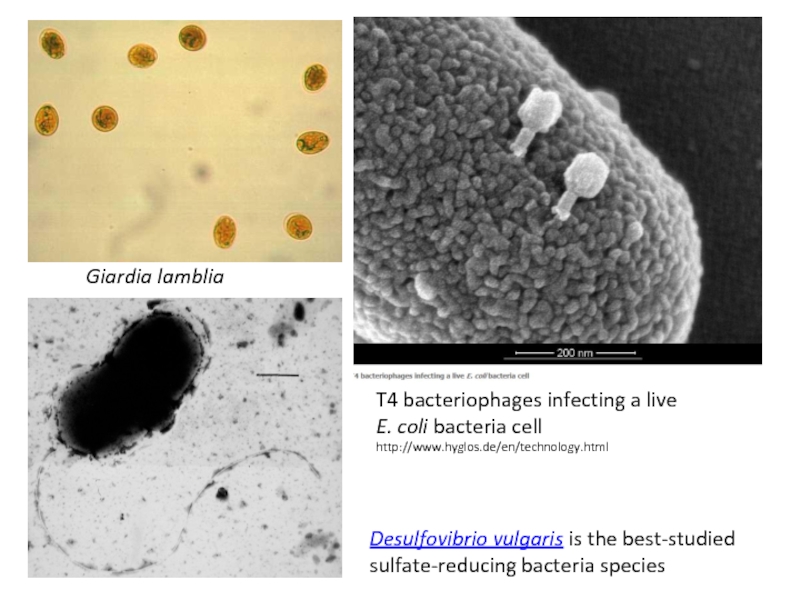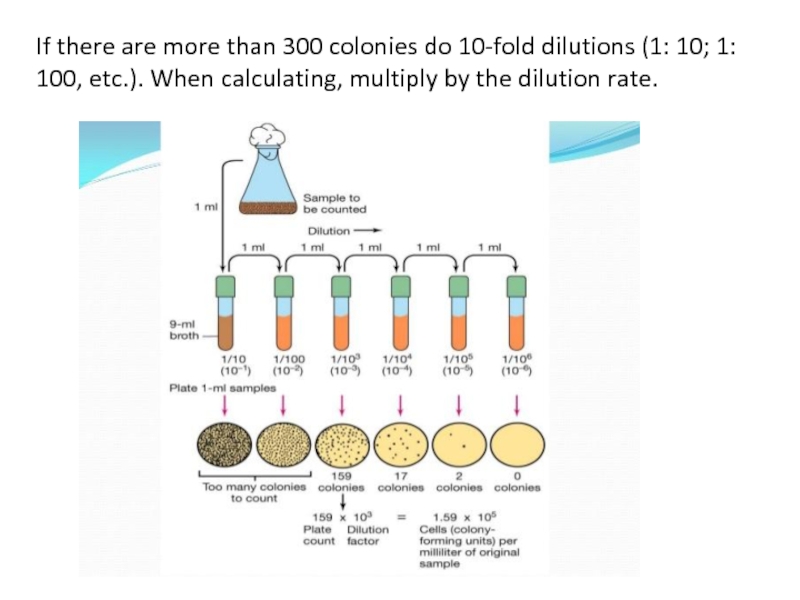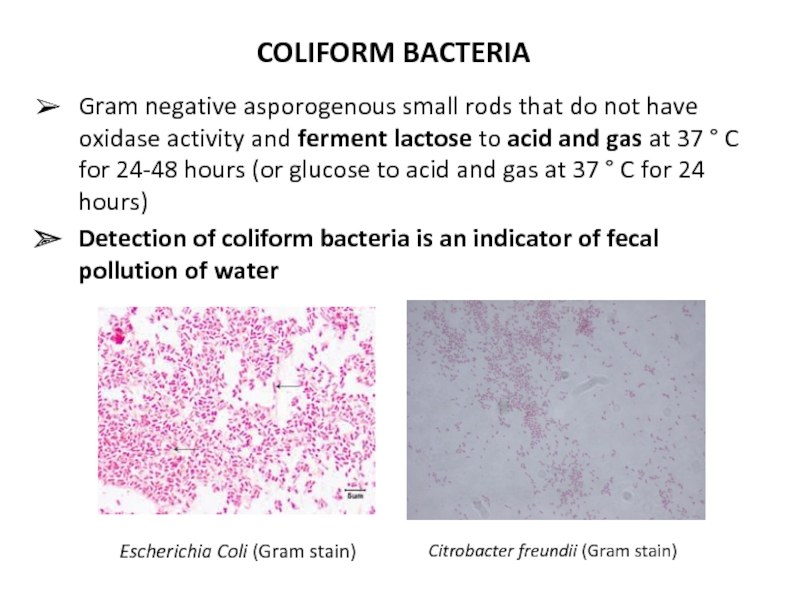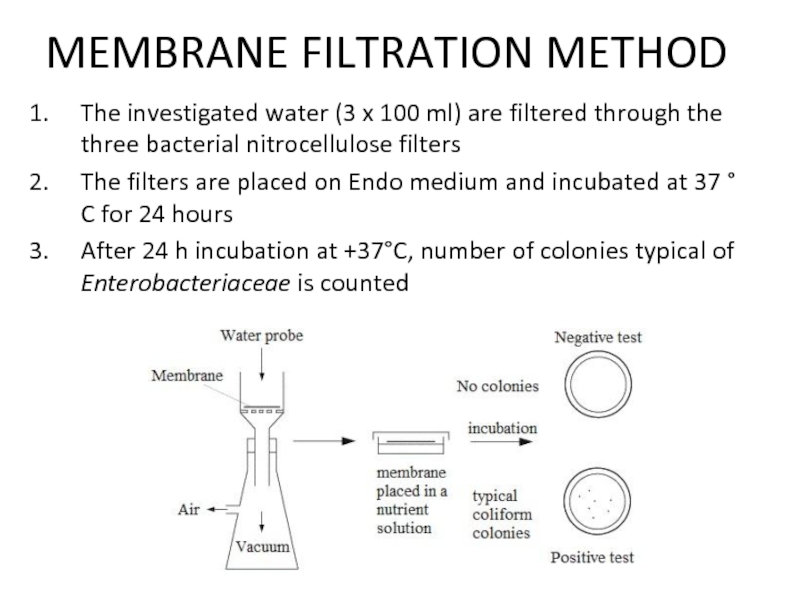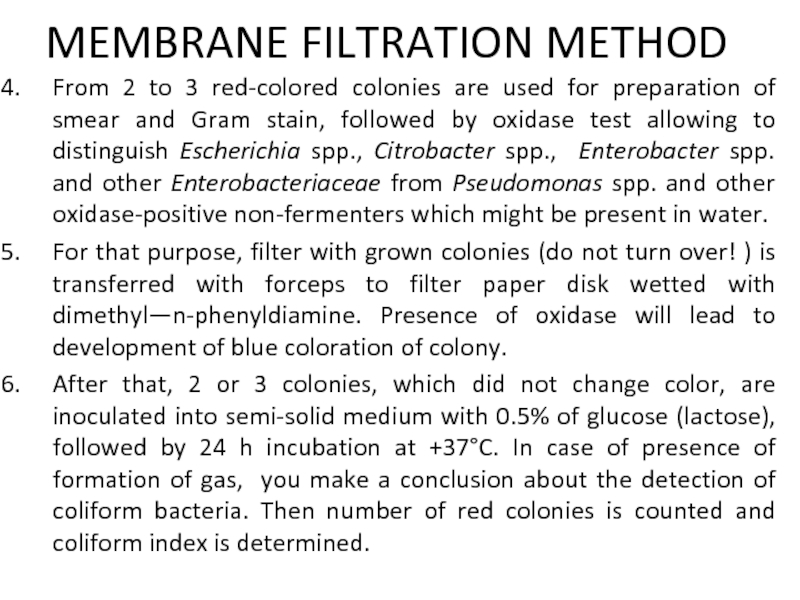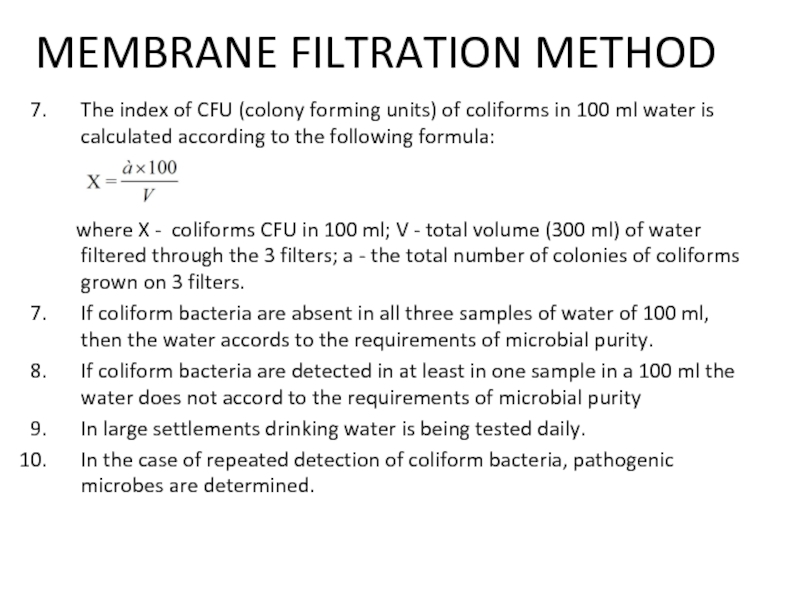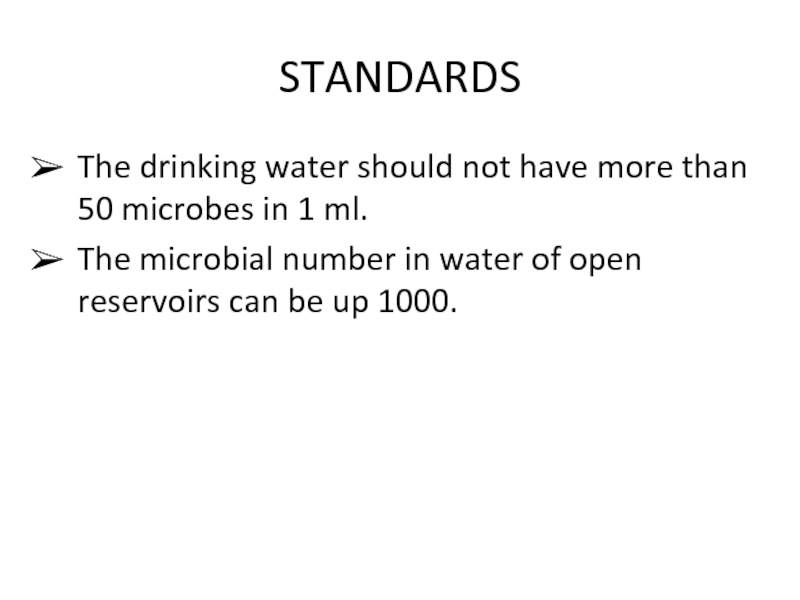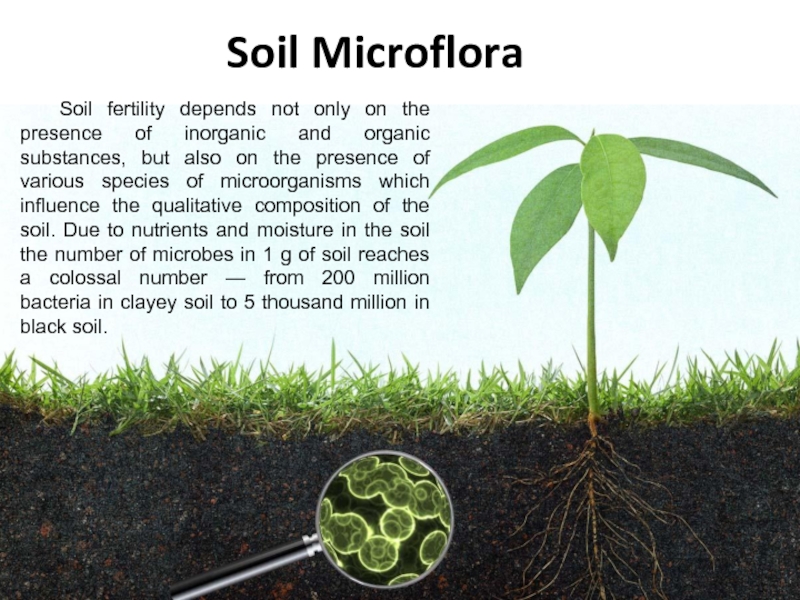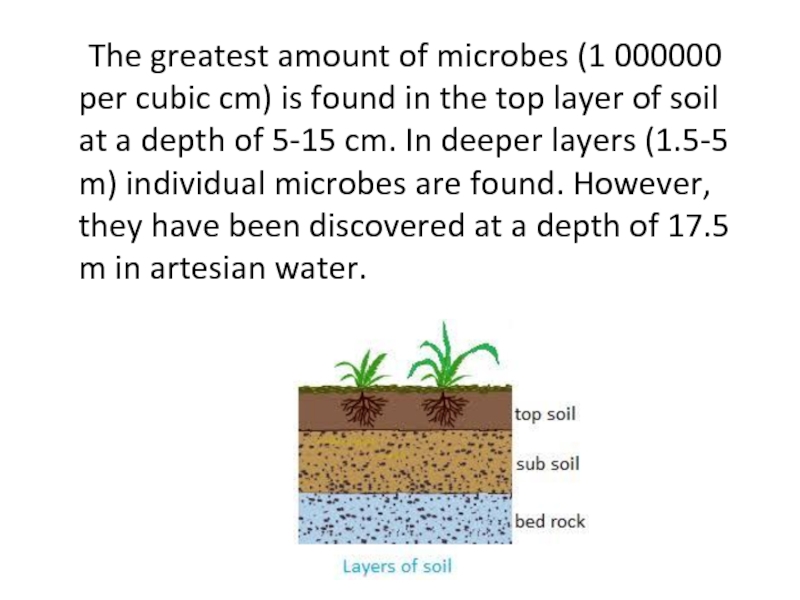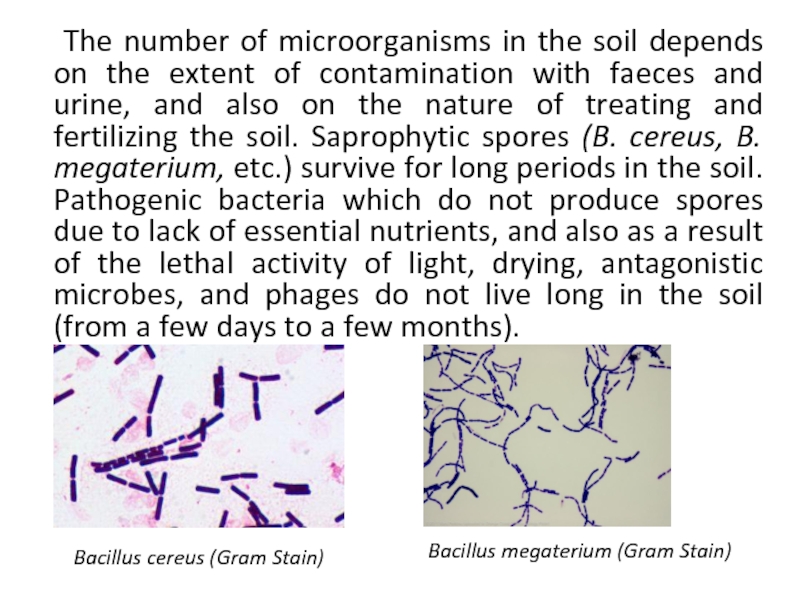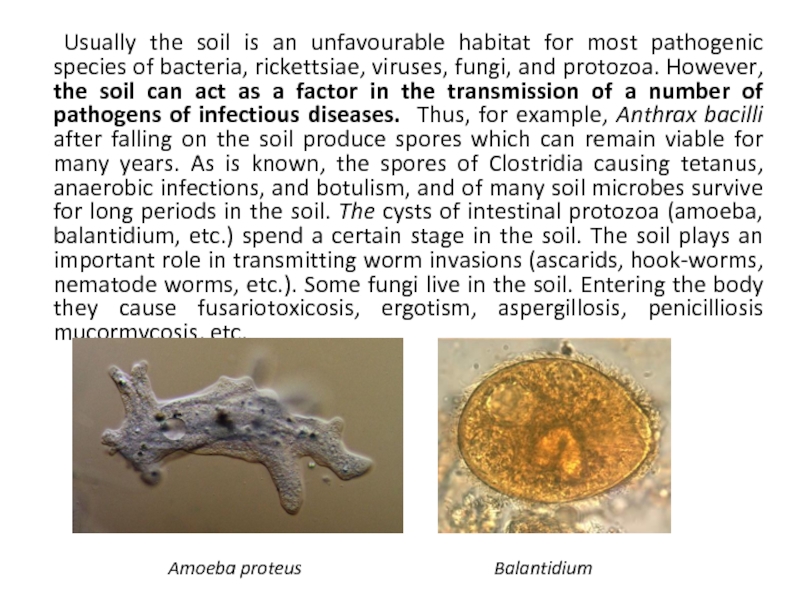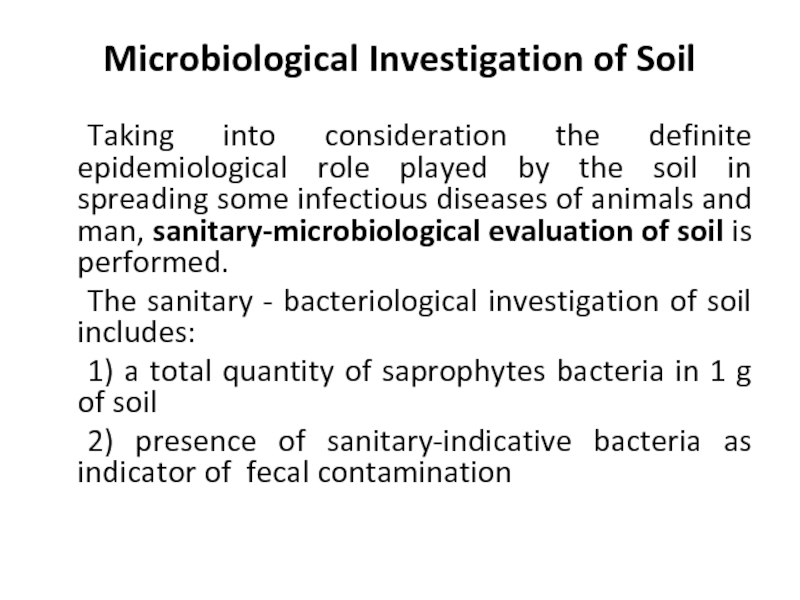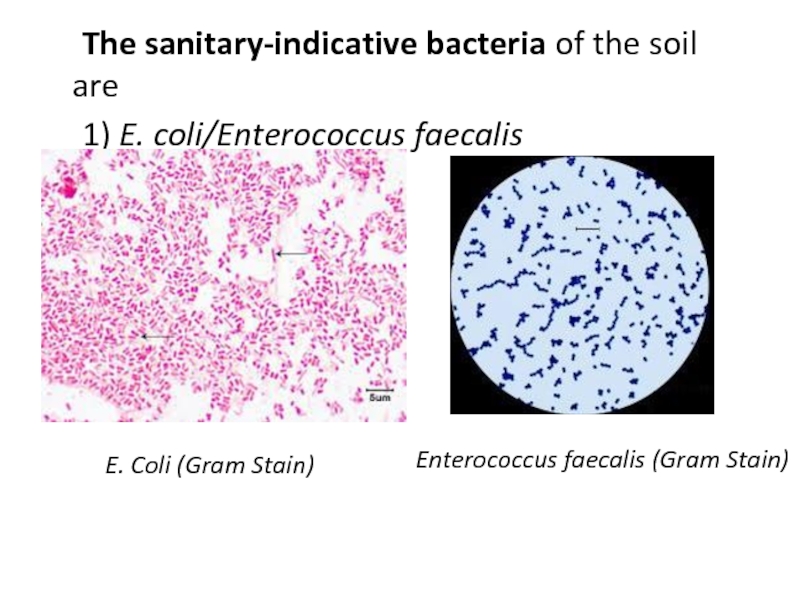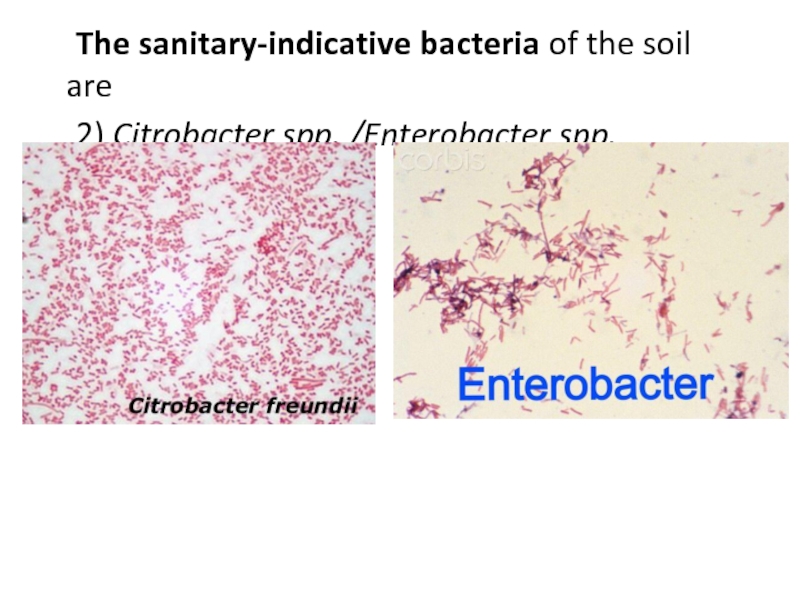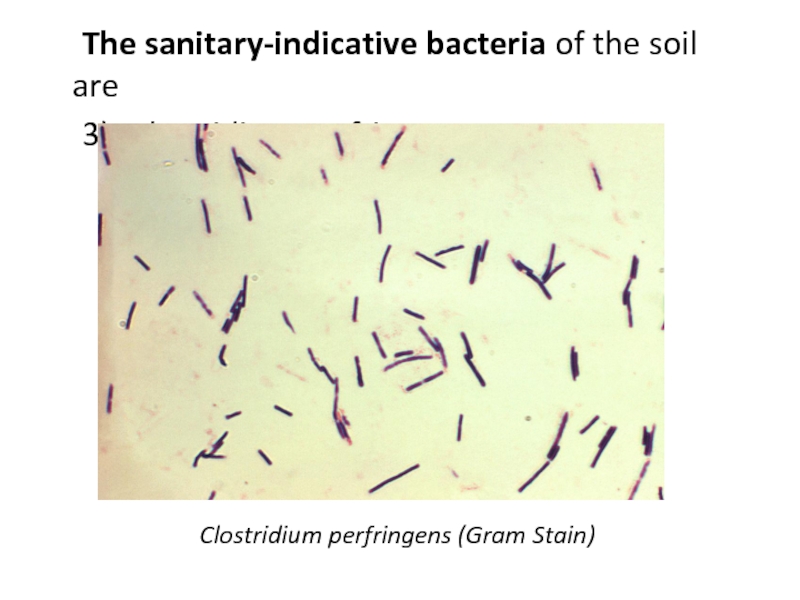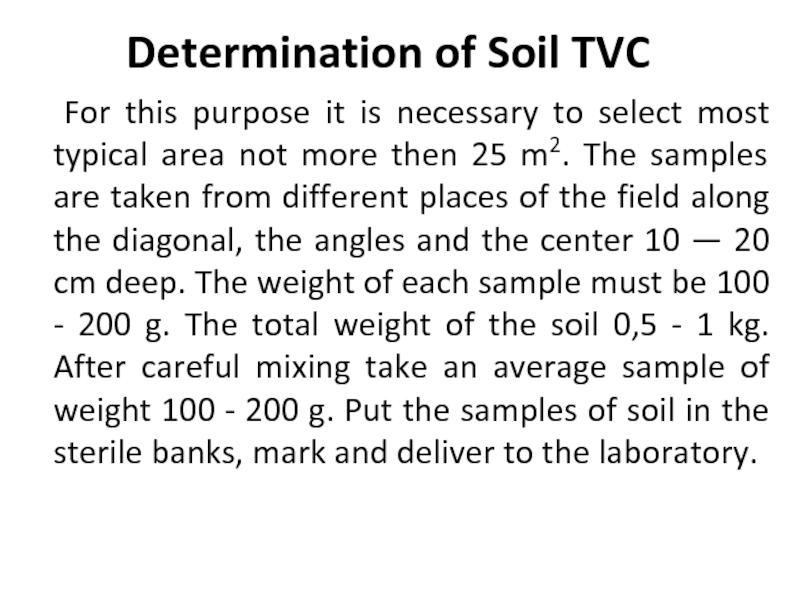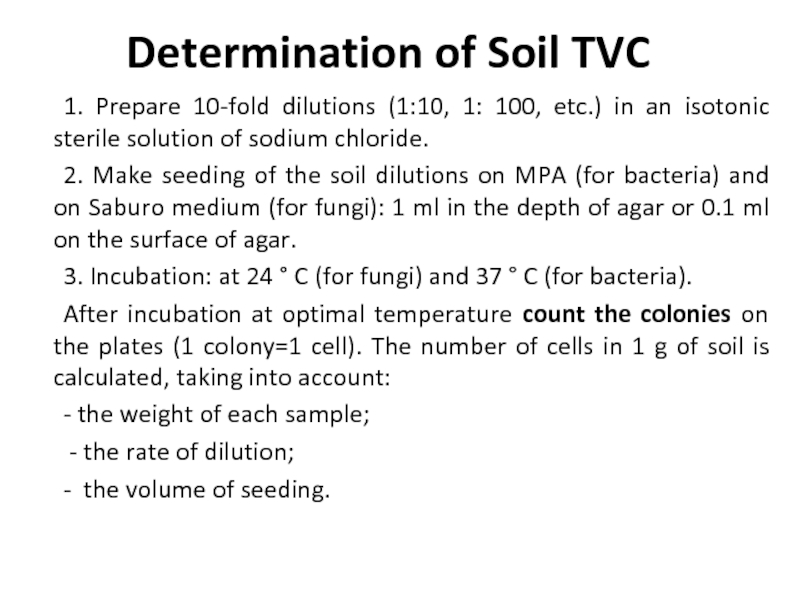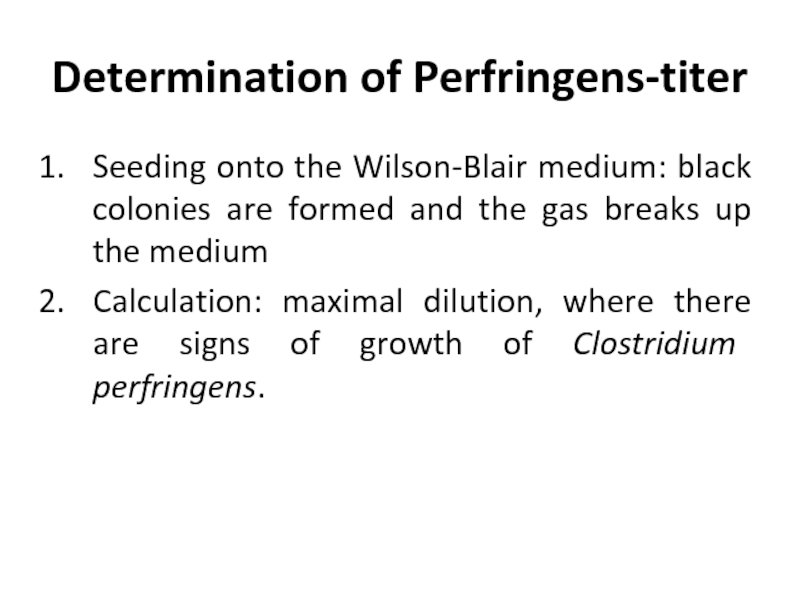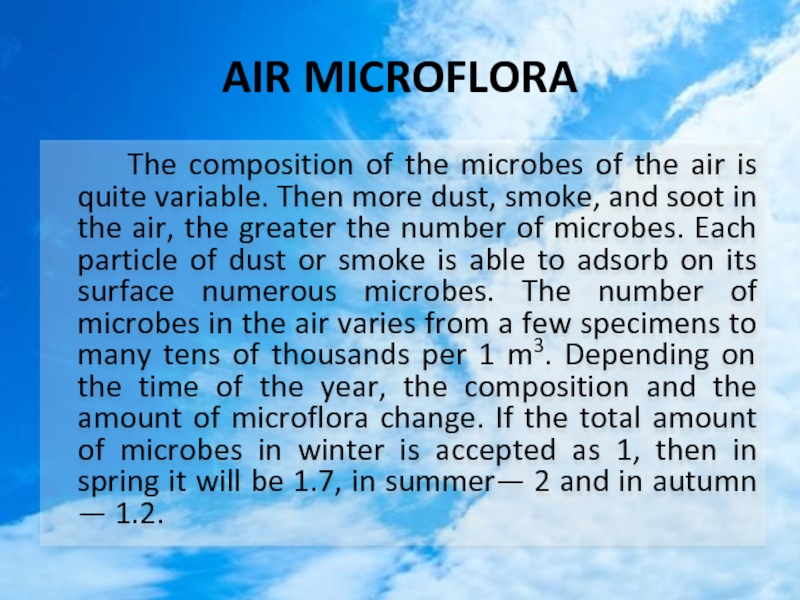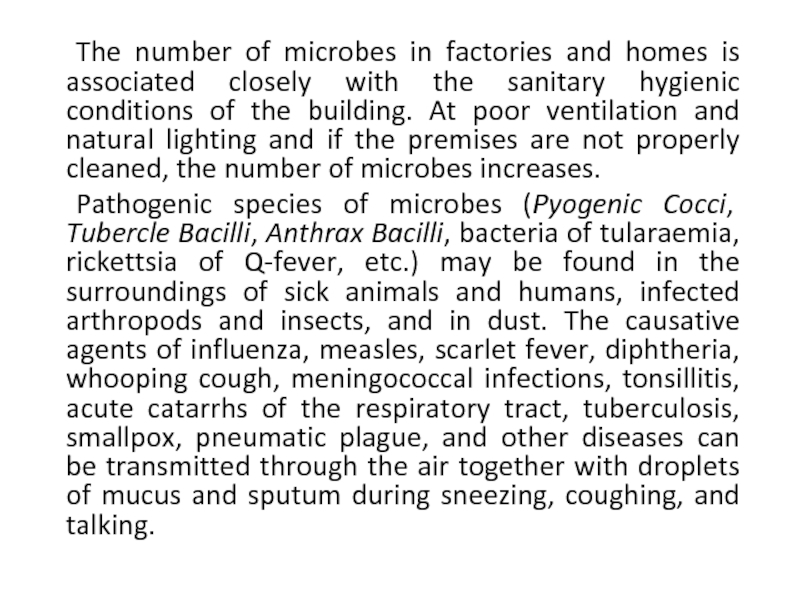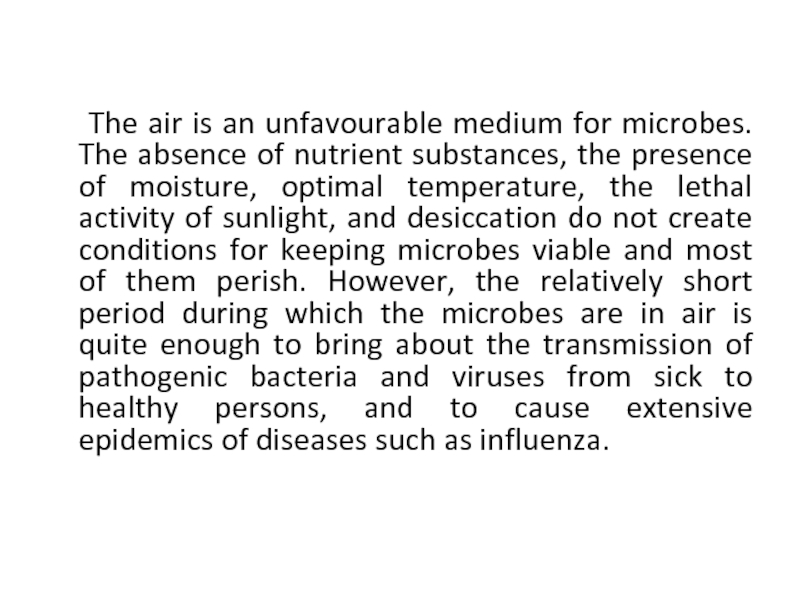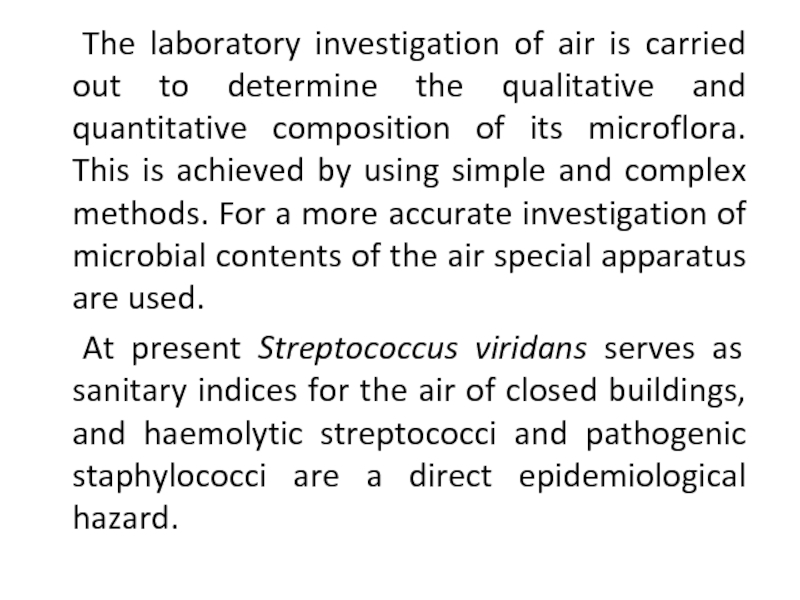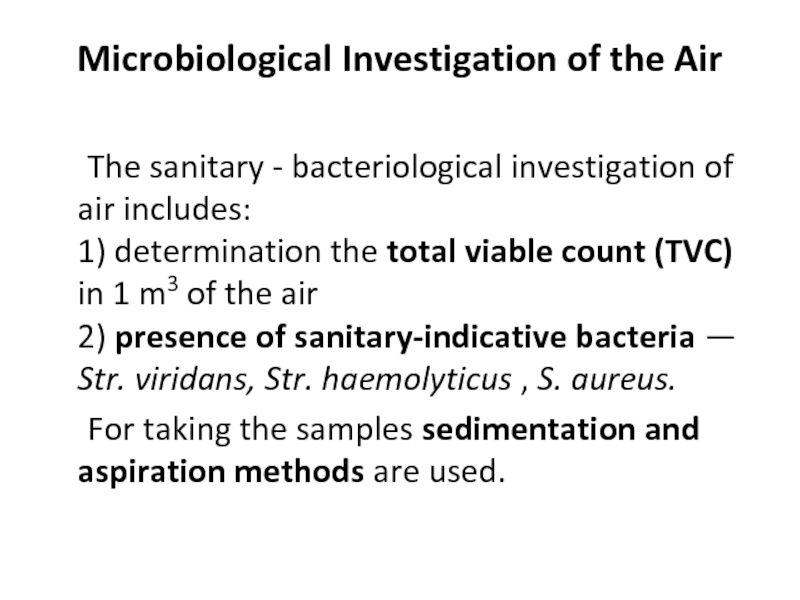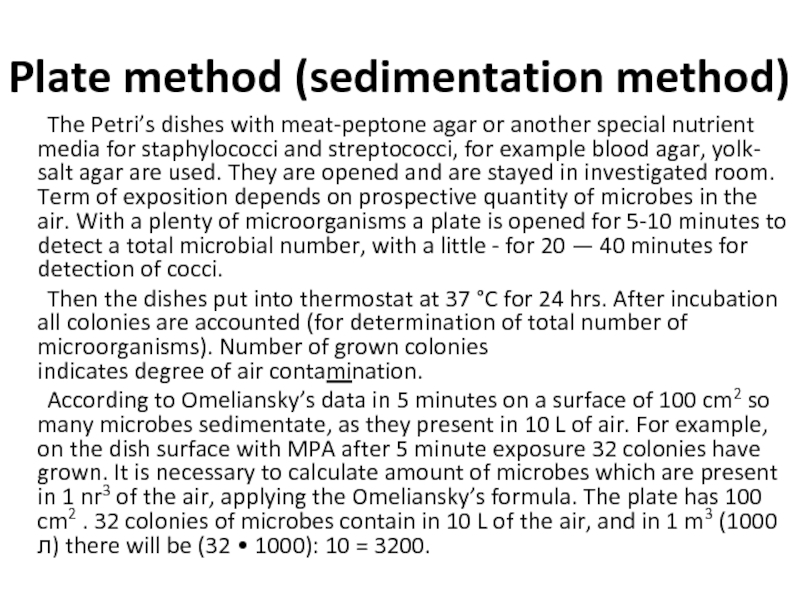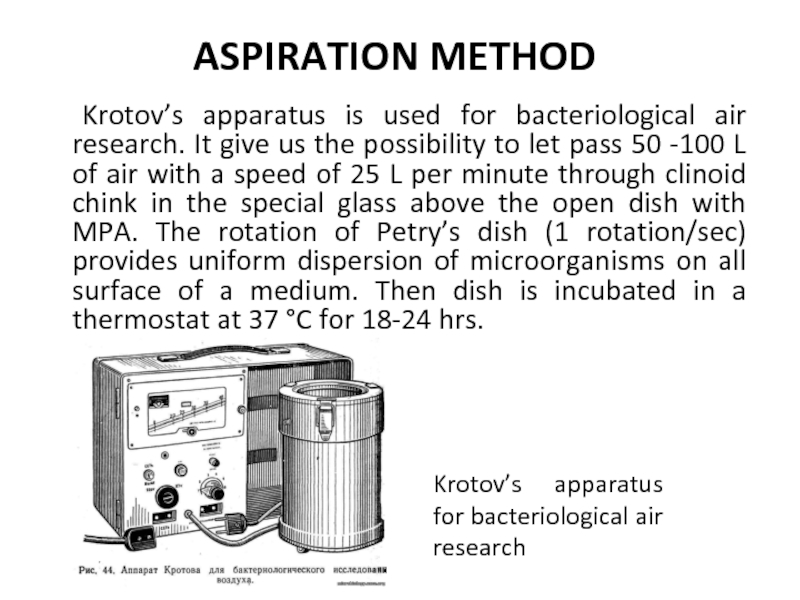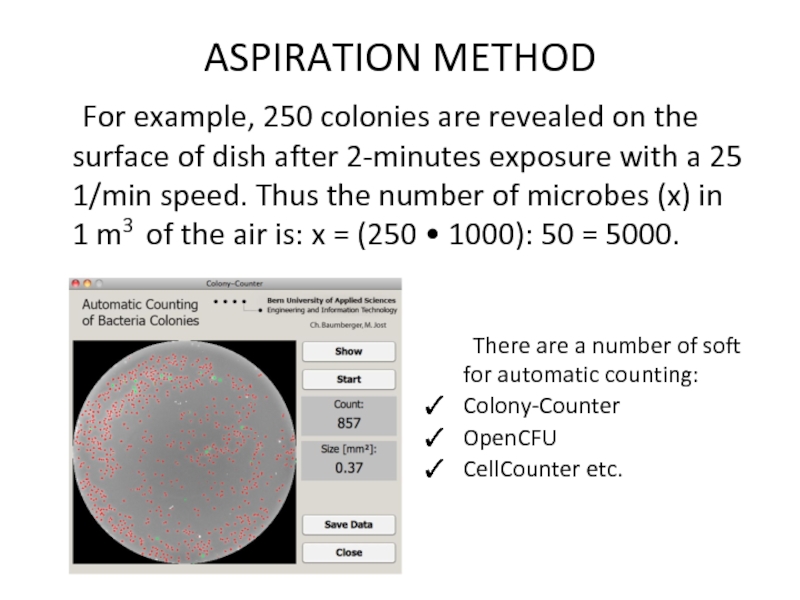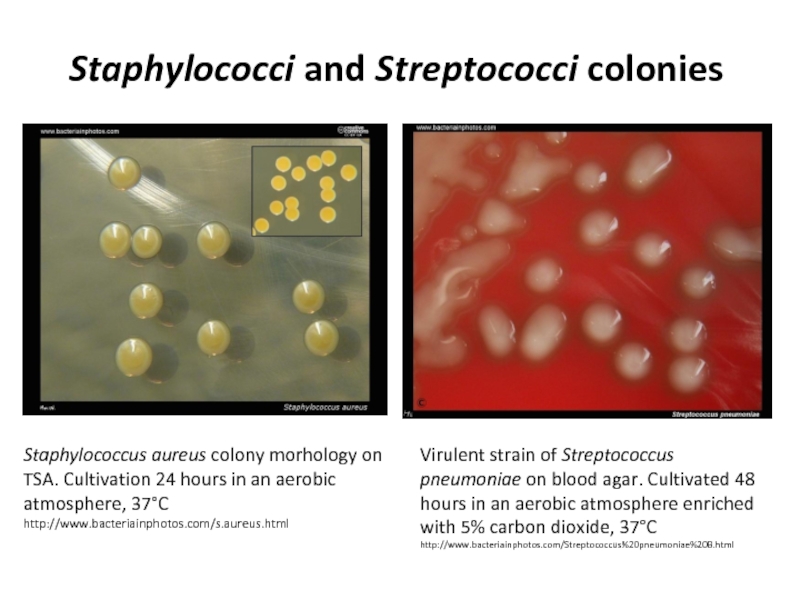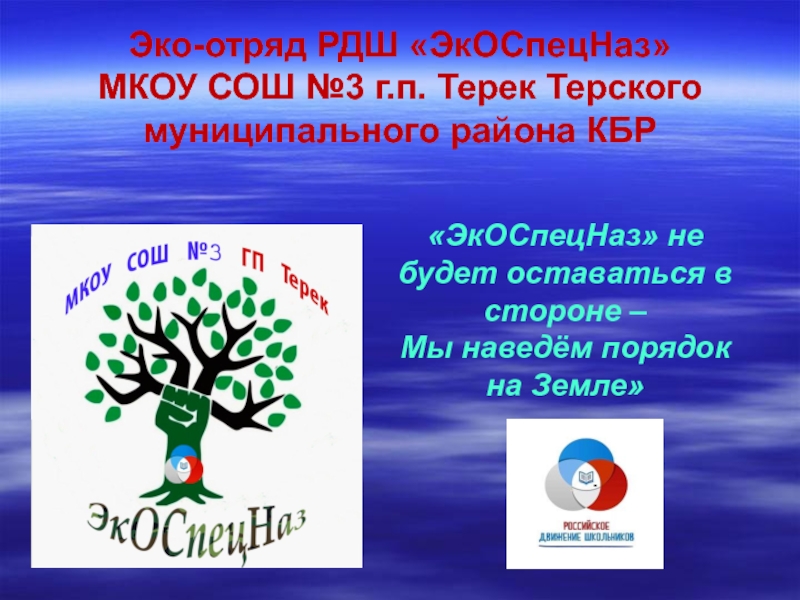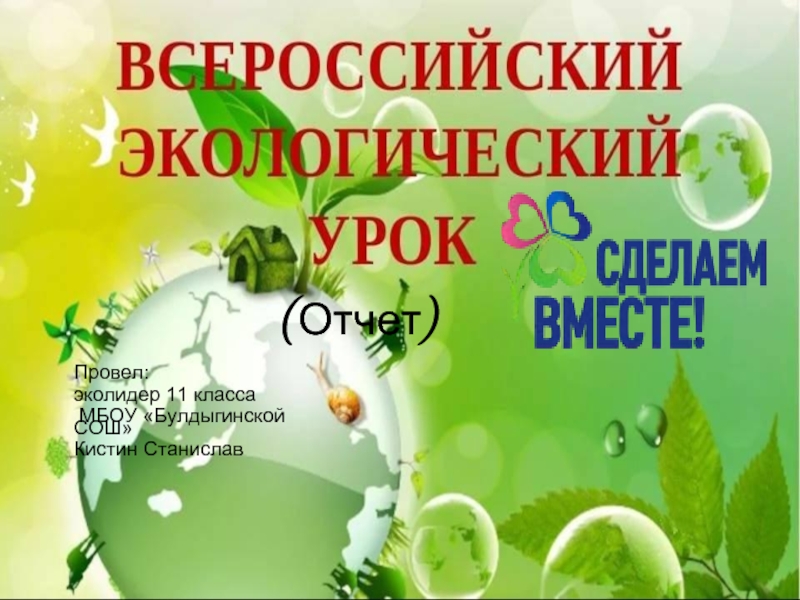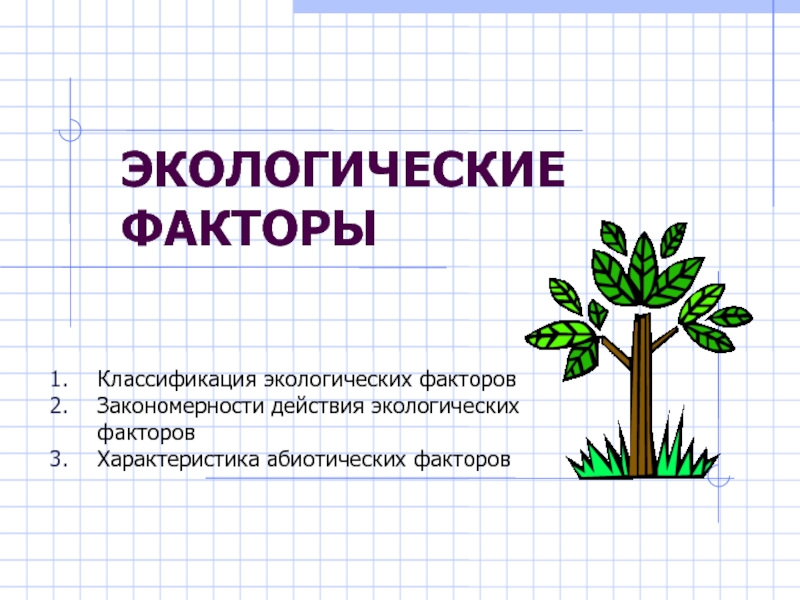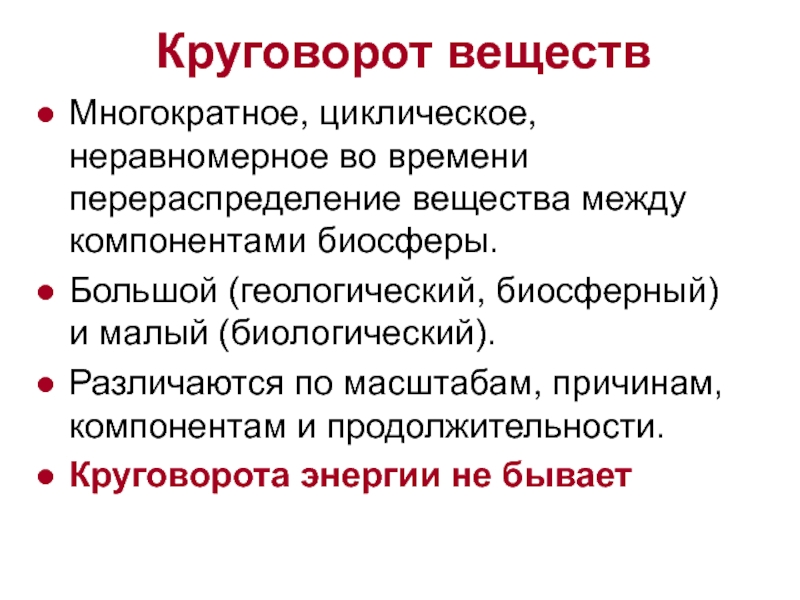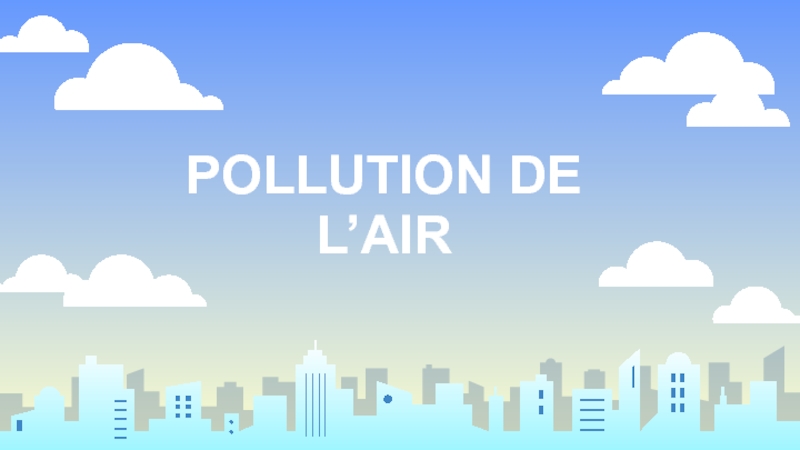- Главная
- Разное
- Дизайн
- Бизнес и предпринимательство
- Аналитика
- Образование
- Развлечения
- Красота и здоровье
- Финансы
- Государство
- Путешествия
- Спорт
- Недвижимость
- Армия
- Графика
- Культурология
- Еда и кулинария
- Лингвистика
- Английский язык
- Астрономия
- Алгебра
- Биология
- География
- Детские презентации
- Информатика
- История
- Литература
- Маркетинг
- Математика
- Медицина
- Менеджмент
- Музыка
- МХК
- Немецкий язык
- ОБЖ
- Обществознание
- Окружающий мир
- Педагогика
- Русский язык
- Технология
- Физика
- Философия
- Химия
- Шаблоны, картинки для презентаций
- Экология
- Экономика
- Юриспруденция
Microflora and sanitary-indicative bacteria of the soil, water, air the methods of studying презентация
Содержание
- 1. Microflora and sanitary-indicative bacteria of the soil, water, air the methods of studying
- 2. Microorganisms are widespread. Microbes are distributed everywhere
- 3. The environment is a transmission factor of
- 4. Sanitary microbiology is a science that studies
- 5. Direct detection of pathogenic microorganisms in the
- 6. Total viable count (TVC) is used
- 7. Sanitary-indicative microorganisms (SIMs) or sanitary-indicative bacteria are
- 8. Presence of Escherichia coli and Enterococcus faecalis
- 9. Simultaneous isolation of Staphylococcus aureus and hemolytic
- 10. If the amount of SIMs increases in
- 11. WATER MICROFLORA Pseudomonas fluorescens, Micrococcus roseus etc.,
- 12. The microflora of rivers depends on the
- 13. https://dornsife.usc.edu/labs/laketyrrell/research/
- 14. Water is an important factor for the
- 15. How do we monitor the sanitary quality
- 16. The sanitary - bacteriological investigation of water
- 17. Giardia lamblia T4 bacteriophages infecting a live
- 18. 1. Sampling: 500 ml (tap water and
- 19. If there are more than 300 colonies
- 20. Gram negative asporogenous small rods that do
- 21. MEMBRANE FILTRATION METHOD The investigated water (3
- 22. MEMBRANE FILTRATION METHOD From 2 to 3
- 23. MEMBRANE FILTRATION METHOD The index of CFU
- 24. What are the standards for drinking water?
- 25. STANDARDS The drinking water should not have
- 26. Soil Microflora Soil fertility depends not only
- 27. Soil microflora consists bacteria (nitrifying, nitrogen-fixing, denitrifying),
- 28. The greatest amount of microbes (1 000000
- 29. The number of microorganisms in the soil
- 30. Usually the soil is an unfavourable habitat
- 31. Taking into consideration the definite epidemiological role
- 32. The sanitary-indicative bacteria of the soil are
- 33. The sanitary-indicative bacteria of the soil are 2) Citrobacter spp. /Enterobacter spp.
- 34. The sanitary-indicative bacteria of the soil are 3) Clostridium perfringens Clostridium perfringens (Gram Stain)
- 35. More accurate evaluation is performed using coli-index
- 36. Determination of Soil TVC For this purpose
- 37. Determination of Soil TVC 1. Prepare 10-fold
- 38. Determination of Perfringens-titer Seeding onto the Wilson-Blair
- 39. AIR MICROFLORA The composition of the microbes
- 40. The number of microbes in factories and
- 41. Pathogenic Species of Microbes Mycobacterium tuberculosis (Gram
- 42. The air is an unfavourable medium for
- 43. The laboratory investigation of air is carried
- 44. Sanitary-indicative bacteria of air of closed buildings
- 45. The sanitary - bacteriological investigation of air
- 46. Plate method (sedimentation method) The Petri’s dishes
- 47. ASPIRATION METHOD Krotov’s apparatus is used for
- 48. ASPIRATION METHOD For example, 250 colonies are
- 49. Determination of Staphylococci and Streptococci Using
- 50. Staphylococci and Streptococci colonies Staphylococcus aureus colony morhology
- 51. To the air environment of pharmacies strict
Слайд 2 Microorganisms are widespread. Microbes are distributed everywhere in the environment surrounding
Soil
Water
Air
Plants
Animals
Food products
In the human body and on the surface of the human body
Слайд 3 The environment is a transmission factor of infectious diseases. Potentially pathogenic
1) fecal (with excrement from the intestine)
2) airborne (with droplets of mucus from the respiratory tract)
Thus sanitary-microbiological investigations are performed for study and evaluation of different objects for determination of their epidemic potential.
Слайд 4 Sanitary microbiology is a science that studies the microflora of the
Methods for sanitary-microbiological investigation include:
1) determination of a total microbial contamination
2)detection and titration of sanitary-indicative microorganisms
3)detection of pathogenic microorganisms and/or their metabolites
Слайд 5 Direct detection of pathogenic microorganisms in the different objects of environment,
Thus indirect methods of detection of microbial contamination are used:
1) total microbial contamination as indicator of intensity of contamination by organic substances;
2) contamination by sanitary- indicative microorganisms.
Слайд 6 Total viable count (TVC) is used for evaluation of total
TVC is the number of microbes in 1 ml of water, 1 g of soil , in 1 m3 of air.
Слайд 7 Sanitary-indicative microorganisms (SIMs) or sanitary-indicative bacteria are used for indirect evaluation
SIMs features:
are representatives of normal human microflora and homeothermic animals and do not have other habitats
get to environment the same ways (fecal and airdrop), as pathogenic m/o
the same terms are maintained, as pathogenic m/o
its number is constant (they do not multiply in the environment)
methods for determining them are easy and affordable
have stable and typical properties, so they are easily identified and are quantifiable.
Слайд 8 Presence of Escherichia coli and Enterococcus faecalis on environmental objects is
Escherichia coli (Gram stain)
Enterococcus faecalis (Gram stain)
Слайд 9 Simultaneous isolation of Staphylococcus aureus and hemolytic streptococci indicates possible contamination
Staphylococcus aureus seen under microscope after Gram's staining
Слайд 10 If the amount of SIMs increases in environmental objects, the probability
Presence of sanitary-indicative microorganisms is measured by titer and index.
The titer is a minimal mass (in g) or volume (in ml), where else are detected SIMs.
The index is the amount of SIMs contained in a 1 l of water, 1 g of soil, 1 m3 of air.
Слайд 11WATER MICROFLORA
Pseudomonas fluorescens, Micrococcus roseus etc., are among the specific aquatic
Pseudomonas fluorescens (Gram stain)
Micrococcus roseus (Gram stain)
Слайд 12 The microflora of rivers depends on the degree of pollution and
Слайд 14 Water is an important factor for the transmission of a number
Int. J. Environ. Res. Public Health 2010, 7, 3657-3703; doi:10.3390/ijerph7103657
Слайд 15How do we monitor the sanitary quality of water?
There are many
Слайд 16 The sanitary - bacteriological investigation of water includes:
1) determination of
2) determination of coliform bacteria, as indicator of fecal pollution (they live in the intestine, representatives of normal human intestine microflora)
3) presence of spores of sulphite-reducing bacteria and cysts of Giardia lamblia
4) presence of bacteriophages of E. coli
5) detection of pathogenic microbes in case of epidemiological necessity
Due to the enormous sanitary-epidemiological role of water in relation to the intestinal group of diseases, it became necessary to work out rapid indicator methods for revealing coliform and pathogenic bacteria in water.
Слайд 17Giardia lamblia
T4 bacteriophages infecting a live
E. coli bacteria cell
http://www.hyglos.de/en/technology.html
Desulfovibrio vulgaris is the best-studied
Слайд 18 1. Sampling: 500 ml (tap water and purified water), 20 ml
2. 1 ml of water is seeded in at least 2 Petri dishes according to Koch's deep method on MPA.
3. Incubation: 37 ° C, 24 hours.
4. Calculation: count the number of colonies on both plates, add up and divide by
The result is expressed in CFU(colony forming units) / ml.
Take into account only those Petri dishes, where no more than 300 colonies have grown.
WATER TVC DETERMINATION
Слайд 19If there are more than 300 colonies do 10-fold dilutions (1:
Слайд 20Gram negative asporogenous small rods that do not have oxidase activity
Detection of coliform bacteria is an indicator of fecal pollution of water
COLIFORM BACTERIA
Escherichia Coli (Gram stain)
Citrobacter freundii (Gram stain)
Слайд 21MEMBRANE FILTRATION METHOD
The investigated water (3 x 100 ml) are filtered
The filters are placed on Endo medium and incubated at 37 ° C for 24 hours
After 24 h incubation at +37°C, number of colonies typical of Enterobacteriaceae is counted
Слайд 22MEMBRANE FILTRATION METHOD
From 2 to 3 red-colored colonies are used for
For that purpose, filter with grown colonies (do not turn over! ) is transferred with forceps to filter paper disk wetted with dimethyl—n-phenyldiamine. Presence of oxidase will lead to development of blue coloration of colony.
After that, 2 or 3 colonies, which did not change color, are inoculated into semi-solid medium with 0.5% of glucose (lactose), followed by 24 h incubation at +37°C. In case of presence of formation of gas, you make a conclusion about the detection of coliform bacteria. Then number of red colonies is counted and coliform index is determined.
Слайд 23MEMBRANE FILTRATION METHOD
The index of CFU (colony forming units) of coliforms
where X - coliforms CFU in 100 ml; V - total volume (300 ml) of water filtered through the 3 filters; a - the total number of colonies of coliforms grown on 3 filters.
If coliform bacteria are absent in all three samples of water of 100 ml, then the water accords to the requirements of microbial purity.
If coliform bacteria are detected in at least in one sample in a 100 ml the water does not accord to the requirements of microbial purity
In large settlements drinking water is being tested daily.
In the case of repeated detection of coliform bacteria, pathogenic microbes are determined.
Слайд 24What are the standards for drinking water?
The USEPA issued revised Primary
The best way to ensure water safety - protection of water sources from microbial contamination!
Слайд 25STANDARDS
The drinking water should not have more than 50 microbes in
The microbial number in water of open reservoirs can be up 1000.
Слайд 26Soil Microflora
Soil fertility depends not only on the presence of inorganic
Слайд 27 Soil microflora consists bacteria (nitrifying, nitrogen-fixing, denitrifying), cellulose-splitting and sulfur bacteria,
Слайд 28 The greatest amount of microbes (1 000000 per cubic cm) is
Слайд 29 The number of microorganisms in the soil depends on the extent
Bacillus cereus (Gram Stain)
Bacillus megaterium (Gram Stain)
Слайд 30 Usually the soil is an unfavourable habitat for most pathogenic species
Amoeba proteus
Balantidium
Слайд 31 Taking into consideration the definite epidemiological role played by the soil
The sanitary - bacteriological investigation of soil includes:
1) a total quantity of saprophytes bacteria in 1 g of soil
2) presence of sanitary-indicative bacteria as indicator of fecal contamination
Microbiological Investigation of Soil
Слайд 32 The sanitary-indicative bacteria of the soil are
1) E. coli/Enterococcus faecalis
E.
Enterococcus faecalis (Gram Stain)
Слайд 34 The sanitary-indicative bacteria of the soil are
3) Clostridium perfringens
Clostridium perfringens
Слайд 35 More accurate evaluation is performed using
coli-index — number of Enterobacteriaceae (so
perfringens-titer - mass of soil in which 1 cell C. perfringens is found.
Слайд 36Determination of Soil TVC
For this purpose it is necessary to select
Слайд 37Determination of Soil TVC
1. Prepare 10-fold dilutions (1:10, 1: 100, etc.)
2. Make seeding of the soil dilutions on MPA (for bacteria) and on Saburo medium (for fungi): 1 ml in the depth of agar or 0.1 ml on the surface of agar.
3. Incubation: at 24 ° C (for fungi) and 37 ° C (for bacteria).
After incubation at optimal temperature count the colonies on the plates (1 colony=1 cell). The number of cells in 1 g of soil is calculated, taking into account:
- the weight of each sample;
- the rate of dilution;
- the volume of seeding.
Слайд 38Determination of Perfringens-titer
Seeding onto the Wilson-Blair medium: black colonies are formed
Calculation: maximal dilution, where there are signs of growth of Clostridium perfringens.
Слайд 39AIR MICROFLORA
The composition of the microbes of the air is quite
Слайд 40 The number of microbes in factories and homes is associated closely
Pathogenic species of microbes (Pyogenic Cocci, Tubercle Bacilli, Anthrax Bacilli, bacteria of tularaemia, rickettsia of Q-fever, etc.) may be found in the surroundings of sick animals and humans, infected arthropods and insects, and in dust. The causative agents of influenza, measles, scarlet fever, diphtheria, whooping cough, meningococcal infections, tonsillitis, acute catarrhs of the respiratory tract, tuberculosis, smallpox, pneumatic plague, and other diseases can be transmitted through the air together with droplets of mucus and sputum during sneezing, coughing, and talking.
Слайд 41Pathogenic Species of Microbes
Mycobacterium tuberculosis (Gram Stain)
Anthrax bacilli (Gram Stain)
Francisella tularensis
Слайд 42 The air is an unfavourable medium for microbes. The absence of
Слайд 43 The laboratory investigation of air is carried out to determine the
At present Streptococcus viridans serves as sanitary indices for the air of closed buildings, and haemolytic streptococci and pathogenic staphylococci are a direct epidemiological hazard.
Слайд 44 Sanitary-indicative bacteria of air of closed buildings are
1) Streptococcus viridans
2)
3) Staphylococcus aureus
These bacteria are indicators of contamination by oral droplets.
Streptococcus viridans
(Gram stain)
Staphylococcus aureus
(Gram stain)
Слайд 45 The sanitary - bacteriological investigation of air includes: 1) determination the total
For taking the samples sedimentation and aspiration methods are used.
Microbiological Investigation of the Air
Слайд 46Plate method (sedimentation method)
The Petri’s dishes with meat-peptone agar or another
Then the dishes put into thermostat at 37 °C for 24 hrs. After incubation all colonies are accounted (for determination of total number of microorganisms). Number of grown colonies indicates degree of air contamination.
According to Omeliansky’s data in 5 minutes on a surface of 100 cm2 so many microbes sedimentate, as they present in 10 L of air. For example, on the dish surface with MPA after 5 minute exposure 32 colonies have grown. It is necessary to calculate amount of microbes which are present in 1 nr3 of the air, applying the Omeliansky’s formula. The plate has 100 cm2 . 32 colonies of microbes contain in 10 L of the air, and in 1 m3 (1000 л) there will be (32 • 1000): 10 = 3200.
Слайд 47ASPIRATION METHOD
Krotov’s apparatus is used for bacteriological air research. It give
Krotov’s apparatus for bacteriological air research
Слайд 48ASPIRATION METHOD
For example, 250 colonies are revealed on the surface of
There are a number of soft for automatic counting:
Colony-Counter
OpenCFU
CellCounter etc.
Слайд 49Determination of
Staphylococci and Streptococci
Using Krotov’s apparatus 250 L of air
Слайд 50Staphylococci and Streptococci colonies
Staphylococcus aureus colony morhology on TSA. Cultivation 24 hours
http://www.bacteriainphotos.com/s.aureus.html
Virulent strain of Streptococcus pneumoniae on blood agar. Cultivated 48 hours in an aerobic atmosphere enriched with 5% carbon dioxide, 37°C
http://www.bacteriainphotos.com/Streptococcus%20pneumoniae%20B.html
Слайд 51 To the air environment of pharmacies strict hygienic requirements are imposed,
Sources of air pollution pharmacies:
Visitors
Employees
Infected material (recipes, dishes, packaging material)
Poor-quality medicinal plant raw materials.
The permissible standards of the microbial number of air in various pharmacy premises have also been developed.
